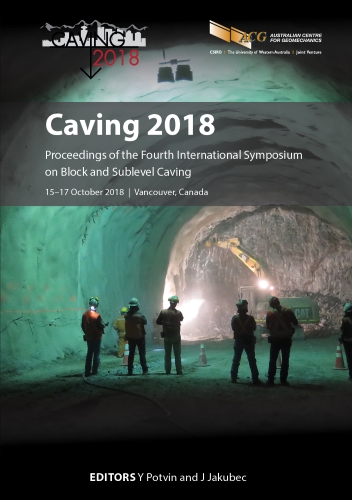Developing projects using CaveLogicTM

|
Authors: Arancibia, M; Soto, F |
DOI https://doi.org/10.36487/ACG_rep/1815_31_Arancibia
Cite As:
Arancibia, M & Soto, F 2018, 'Developing projects using CaveLogicTM', in Y Potvin & J Jakubec (eds), Caving 2018: Proceedings of the Fourth International Symposium on Block and Sublevel Caving, Australian Centre for Geomechanics, Perth, pp. 407-418, https://doi.org/10.36487/ACG_rep/1815_31_Arancibia
Abstract:
This paper presents a new long-term planning software tool to develop projects exploited by mass caving methods. There are no easy to use applications currently available on the market. The software packages available commonly act as black boxes, are complex to use, and generally require highly specialised knowledge and training. The fundamental idea behind CaveLogicTM was to develop a friendly and intuitive tool, leaving aside the black boxes, to allow the user to concentrate on cave mine planning and not the software learning process. The application provides tools for the entire cycle from the block model deposit to the generation of long-term production plans. CaveLogicTM integrates the possibility of generating footprints through a genetic algorithm, incorporating restrictions and caving parameters, as well as evaluating multiple scenarios such as multiple undercut level planning. CaveLogicTMenables the simulation of previously caved levels, allowing the planner to interactively modify the optimal solutions presented by the software. This paper involves a case study for a mining project planned for a fictitiousmine transitioning from open pit to mining by caving, enhancing the management of large analysed nodes and block volumes. CaveLogicTM uses an algorithm based on image processing and geomorphology applications, applying genetic algorithm guidelines. The algorithm accomplishes the commissioned task successfully and has a processing time per envelope in the order of seconds. The software includes tools to simulate previously caved sectors, and enables the mine engineer to interactively modify the solutions considered optimal by the software.
Keywords: caving, mine planning, software, genetic algorithm
References:
Arcos Troncoso, CA 2012, Metodología para la Selección del Piso de Hundimiento en Panel Caving, bachelor’s thesis, Universidad de Santiago, Santiago.
Brown, ET 2003, Block Caving Geomechanics, Julius Kruttschnitt Mineral Research Centre, Indooroopilly, and The University of Queensland, Brisbane.
Laubscher, D 1994, ‘Cave mining – the state of the art’, Journal of the South African Institute of Mining and Metallurgy, vol. 94, no. 10, pp. 279–293.
Laubscher, D 2003, Cave Mining Handbook, De Beers, Johannesburg.
Lerchs, H & Grossman, I 1965, ‘Optimum design of open pit mines’, CIM Bulletin, vol. 58, no. 633, pp. 47–54.
Pierce, ME 2010, A Model for Gravity Flow of Fragmented Rock in Block Caving Mines, PhD thesis, The University of Queensland, Brisbane.
Pike, RJ, Evans, IS & Hengl, T 2008, ‘Geomorphometry: a brief guide’, in T Hengl & H Reuter (eds), Geomorphometry: Concepts, Software, Applications, Elsevier, Amsterdam.
Solem, JE 2012, Programming Computer Vision with Python, O'Reilly Media, Sebastopol.
Talbi, EG 2009, Metaheuristics: From Design to Implementation, John Wiley & Sons, Hoboken.
Vargas Vierling, EA 2014, Cálculo Envolvente Económica para Minas de Caving Bajo Incertidumbre Geológica, MSc thesis, Universidad de Chile, Santiago.
© Copyright 2025, Australian Centre for Geomechanics (ACG), The University of Western Australia. All rights reserved.
View copyright/legal information
Please direct any queries or error reports to repository-acg@uwa.edu.au
View copyright/legal information
Please direct any queries or error reports to repository-acg@uwa.edu.au
